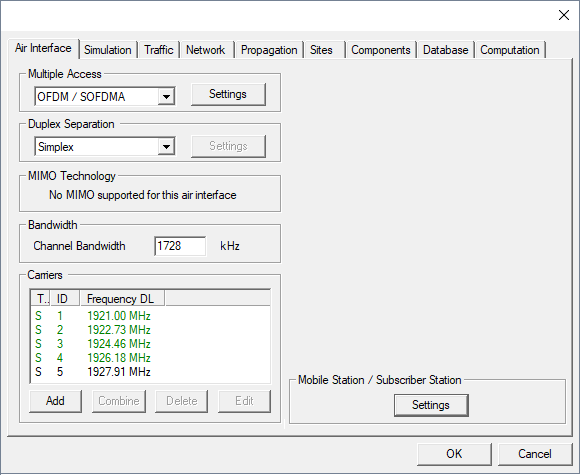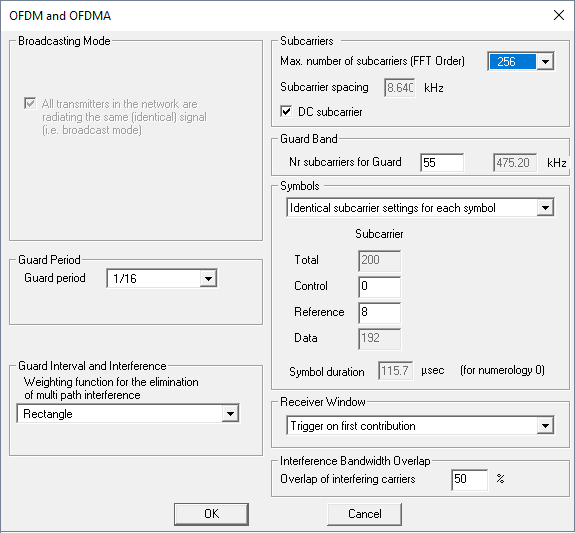OFDM / SOFDMA (Broadcast)
Orthogonal frequency division multiple access is a multiple access scheme, used in nearly all actual and future wireless broadcast air interfaces, such as DAB, DVB-T/DVB-H, and DTMB.
A large number of closely-spaced orthogonal sub-carriers are used to carry data. The data is divided into several parallel channels, one for each sub-carrier. Each sub-carrier is modulated with a conventional modulation scheme (such as QAM or QPSK) at a low symbol rate, maintaining total data rates similar to conventional single-carrier modulation schemes in the same bandwidth.
Air Interface Parameters
All parameters related with a selected air interface can be specified on the Air Interface tab of the Edit Project Parameter dialog. For orthogonal frequency division multiple access for simplex broadcasting networks the following settings are available:

Figure 1. The Edit Project Parameters dialog, Air interface tab.

Figure 2. The OFDM and OFDMA dialog.
- Multiple Access Settings
- Settings related to the multiple access mode (guard period, sub-carriers) can be specified in the dialog shown below, which is reachable by clicking and selecting the Air Interface tab.
- Guard Period
- The selected ratio for the guard period defines the length of the guard interval with respect to the defined symbol duration.
- Guard Interval and Interference
- Sub carriers and Symbols
- Maximum number of sub carriers used (the size of fast Fourier transformation). Sub carrier spacing and symbol duration is calculated automatically based on the specified system parameters. Number of guard, control and reference sub-carriers. The number of data sub-carriers depends on the other parameters specified and is calculated automatically.
- Receiver Window
- Selection of if the receiver window starts at the first contribution above the specified threshold or with the strongest contribution. This is important for the interference computation considering the guard interval.
- Duplex Separation
- For broadcasting simplex mode is used. There are no further settings available.
- MIMO Technology
- MIMO technology is not supported in simplex mode.
- Channel Bandwidth
- Total bandwidth of the channel. This value is used to calculate the thermal noise power.
- Carrier Separation
- Frequency separation of two adjacent carriers. This value is used for determination of adjacent or co-channel interference.
- Cell Assignment
- The first step in the network planning computation is the cell assignment procedure. The best server for each receiver pixel is determined based on the maximum Rx power (for carriers which fulfill the min. power and min. SNIR defined under the Mobile Station settings).
- Mobile Station / Subscriber Station
Output Options
- General Results
- Best Server (Cell Assignment)
- Strongest Transmitter (ID)
- Results related to the cell assignment
- Best Server: Received Power (Cell Assignment)
- Best Server: SNIR (Cell Assignment)
- Serving Carrier: Received Power (Cell Assignment)
- Serving Carrier: SNIR (Cell Assignment)